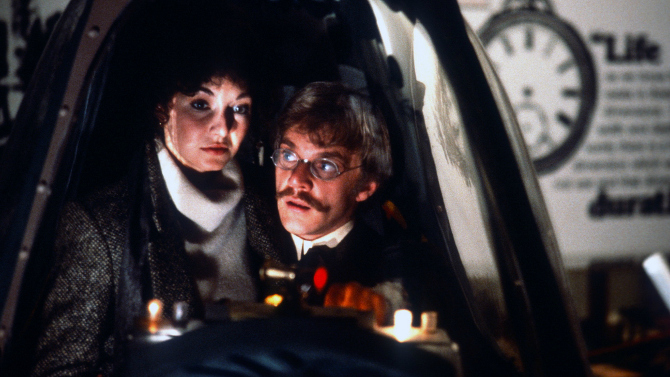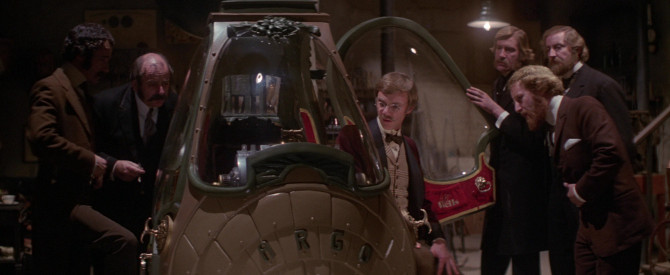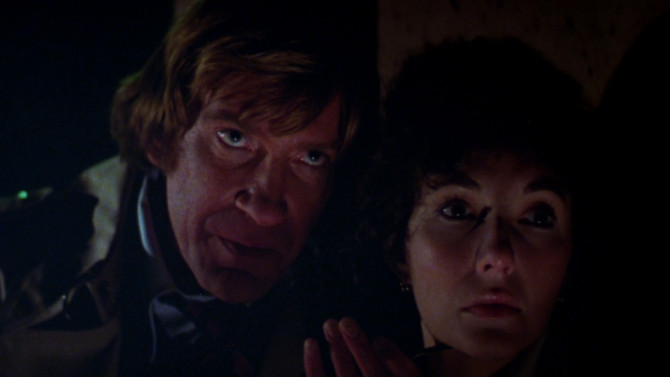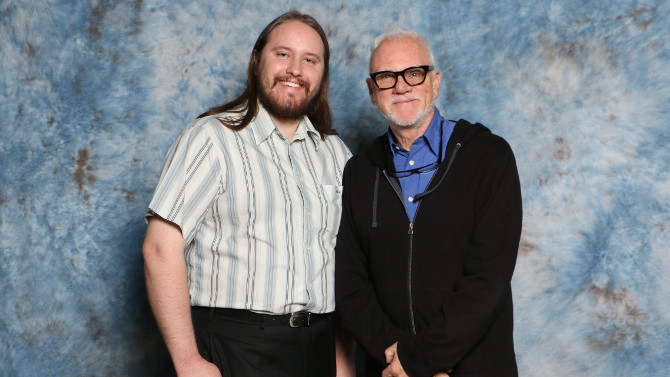“If you fall, I will catch you, I will be waiting. . . Time after time” – Cyndi Lauper
I know you’ve all been desperately waiting for it – my in depth retrospective on the career of Cyndi Lauper. . . alas, you will have to continue to wait. So then, you must all be wondering what exactly the above quote has to do with today’s film. The above song, Time After Time, was inspired by a movie of the same name. . . Lauper writing the hit tune soon after seeing the title in TV Guide.
Adapted and directed by Nicholas Meyer (a screenwriter best known for directing two Star Trek films – yet this was his first directorial effort), and inspired by Steve Hayes and Karl Alexander’s story (the latter had a yet unfinished novel of the same name at the time), this highly original premise finds the great H.G. Wells (Malcolm McDowell – a far cry from his previous film, Caligula) living his life in the late nineteenth century while Jack the Ripper stalks his prey in the streets of London (the opening scene, featuring a lengthy single take, sets the mood – the entire film done tastefully with limited violence shown).
Having frequent get-togethers with his many intellectual friends (where Wells regales his buddies with his theories on the future – women’s liberation, impressive technology, and a vision of utopia), his closest acquaintance is Dr. Stevenson (David Warner), a clever man who always bests the author at chess. On one particular fateful evening, Wells reveals his latest creation – a time machine (with many safeguards – including a key needed to return back to whence you came) that he believes is fully operational (though he doesn’t have the nerve to test it).
As the group continue their party, the police arrive. . . the Ripper has struck again. Searching the house, they learn that Stevenson is the serial killer. . . yet, as soon as they turn their backs, he is gone. Where did he go? Wells’ only hypothesis: the future.
Following the maniacal mastermind, he journeys to 1979, arriving, of all places, in San Francisco. Quickly acclimatizing to the world (and soon realizing that this is no utopia – but, after all, two out of three ain’t bad), mostly thanks to banker Amy Robbins (Mary Steenburgen), she shows the nineteenth century man around – thinking he is merely a very formal British visitor.
Like that aforementioned game of chess, Wells attempts to track down his former friend and now adversary. Yet, this world is not Victorian era England, and Stevenson is relishing this world of killing – in which he is merely an amateur. Guns are easily purchasable, war has evolved into a finely tuned killing machine, and the world is chaos personified. So perhaps, instead of a game of chess, this is more like a game of cat and mouse. . . though in this landscape, it would be hard to argue that Wells is the cat.
In many ways, this sounds like a sci-fi adventure thriller (and it is), though it is just as much a romantic drama. Fusing a story of chases and danger (the murder scenes are cleverly conceived and the chases visually enticing – often with touches of comedy. . . look for an elevator scene shot in the Hyatt Regency – very similar to a sequence found in Mel Brooks’ High Anxiety), with Wells and Robbins quickly falling for each other (much like in real life, for McDowell and Steenburgen fell in love on set, marrying just a year later), but, alas, this is actually a story of three. And as much as Wells loves Robbins, Stevenson loves the idea of killing her – making this a most unholy threesome.
Driven by the three leads, each actor brings their A game. McDowell a visionary fish out of water – like a scientist so involved with his work he sometimes loses track of his present surroundings, while Steenburgen perfectly captures a woman head over heels in love (whilst also being trapped in a most dangerous game), while Warner rounds out the triumvirate as an alluringly sadistic killer – a person you are unable to look away from (much like the characters – to their own detriment).
Overtop, listen for a powerful nineteenth century symphonic-style score from Miklós Rózsa – in wonderful juxtaposition to the sounds of 1979 San Francisco (all of the modern music heard is diagetic – meaning that what we hear is also heard by the characters in the film).
A time travelling tale of love and murder, Time After Time is a creative premise executed in a clever and engaging way. For fans of Wells, there will be many sly winks and nods (from odes to his novels, to Steenburgen’s character name being that of Wells’ second wife). Also keep an eye out for a young boy as Wells first enters the twentieth century – a very young Corey Feldman. Likewise, look for similarities between the time travelling scenes in this and the iconic sci-fi film The Time Machine (based upon Wells’ classic novel). Lastly, I must say I got a kick out of Wells trying to be coy while passing some information on to the police – he utilizes the name Sherlock Holmes to be inconspicuous. So, don’t vaporize this film into oblivion, travel through time and space to discover if any of these characters leave their hearts in San Francisco.




